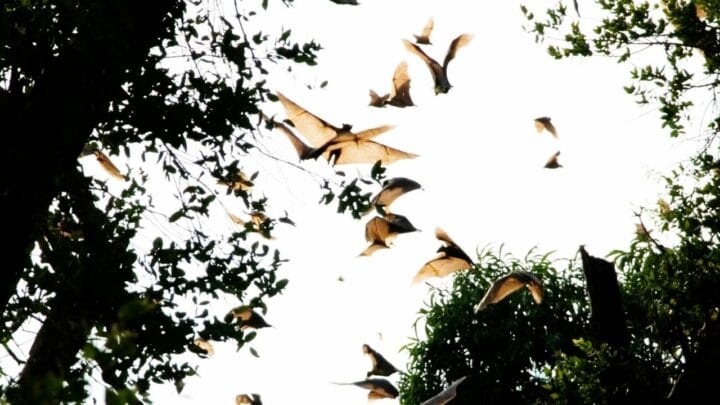While you may be aware that many species of bats hibernate through the winter months, not all types of bats burrow in your attic when it starts to get cold.
Certain bat species have taken a cue from birds and fly south to seek warmer climates during the winter. They may even relocate during the scorching summer heat in search of the ideal conditions for raising their young.
With that said, you may wonder exactly when bats migrate. Fortunately, the bat’s migrating behavior is similar to that of birds, so the answer to this question is fairly simple.
When Do Bats Migrate?
When winter starts to approach, bats will either hibernate or migrate to a warmer climate. The migration can begin as early as September or later from October to November. Additionally, female bats will migrate at other times of the year to seek out ideal temperatures for reproduction and raising their young.
Many Bats Migrate South for the Winter
Yep, certain bat species, especially those who usually roost in trees, will head south to spend the winter months in warmer climates.
This should come as welcoming news as the types of bats that don’t migrate may very well move into your home when the weather gets cold. Fortunately, not all bats hibernate or else basements and attics across the nation will be crowded with bats every winter.
However, the migration doesn’t begin when temperatures reach freezing or the snow begins to fall, or else the bats will freeze to death before they ever reach their destination. Instead, bats will either begin their journey of migration or select their winter hibernation roost as early as September.
This doesn’t necessarily mean that you will spot flocks of bats heading south every September. They will occasionally wait until October or November to make the journey, depending upon the distance to their destination.
Additionally, bats are nocturnal, so it is unlikely that you will see formations of bats flying south in the afternoon as you would with birds. Bats will embark on their journey at nighttime to avoid encounters with predatory birds, such as owls.
They will likely find temporary roosting sites along the way to rest during daylight hours.
Many species of bats that choose migration over the alternative of hibernation will head to places such as Florida or the northern border of Mexico where they migrate each winter season, but some will decide to remain in the warmer climate year-round instead of returning to their former roosting site.
While bats can hunker down and weather the cold temperatures by finding an ideal location to hibernate through the winter, they will freeze if they are directly exposed to temperatures that are too cold, so the decision to migrate or hibernate is necessary for a bat’s survival.
However, there are climates that are ideal for bats throughout the entire year. Florida is one such place that provides a climate that bats can thrive in year-round, which means that not all bats are faced with a survival decision every winter.
Many migrating bats in Florida or Mexico decide to stay there or even migrate slightly north to endure harsh weather in the Southern region.
Bats Migrate to Find the Ideal Location to Raise Their Young
Bats don’t usually migrate farther than 100 to 200 miles from their primary roosting site, and this is especially true of female bats who migrate to find an ideal location for reproduction and raising their young.
Migration takes a lot of energy away from a bat, and many young bats don’t survive their first journey, which is why female bats can be very picky about where they decide to give birth.
Female bats can hold off on delivering their young for as long as seven months to give them sufficient time to find a place that is adequate for their offspring.
The key factor for bats when selecting their ideal location is temperature. Bats can survive at temperatures as low as 35 degrees Fahrenheit or as high as 120 degrees Fahrenheit, but they will freeze to death at temperatures below 35 degrees.
Additionally, excess heat during hibernation will drain them of the energy built up by feeding during the warmer months.
A female bat will seek out a location that is within the appropriate temperature range prior to giving birth. She will also need to select a place that has a nearby food and water source, so migration may very well be necessary to find the perfect place to raise young.
Frequently Asked Questions about When Bats Migrate
Do bats migrate south for winter?
There are many bat species that migrate south to seek food and warmth throughout the winter, rather than hibernate. However, not all bat species migrate. Some will choose to tough out the cold by hibernating in a cave, attic, basement, warehouse, barn, or church. Although bats can’t survive freezing temperatures, they are highly adaptable to environmental changes.
How far do bats migrate?
Since migration takes up a lot of energy, bats rarely migrate any further than 100 to 200 miles one way. The journey is especially difficult for young bats, which makes female bats very particular as to where they decide to give birth.
Conclusion
Not all bats migrate, but those that do usually migrate between September and November every year. Most bats will return north to their prior roost in March or April, while others may decide to remain in climates that are warm year-round.
Female bats may migrate at any time of year to find an ideal location for child-rearing.
Unfortunately, this doesn’t mean that your attic will be free of bats this winter, but it does mean that your neighborhood bat population may likely be reduced when the weather starts to get cold.


